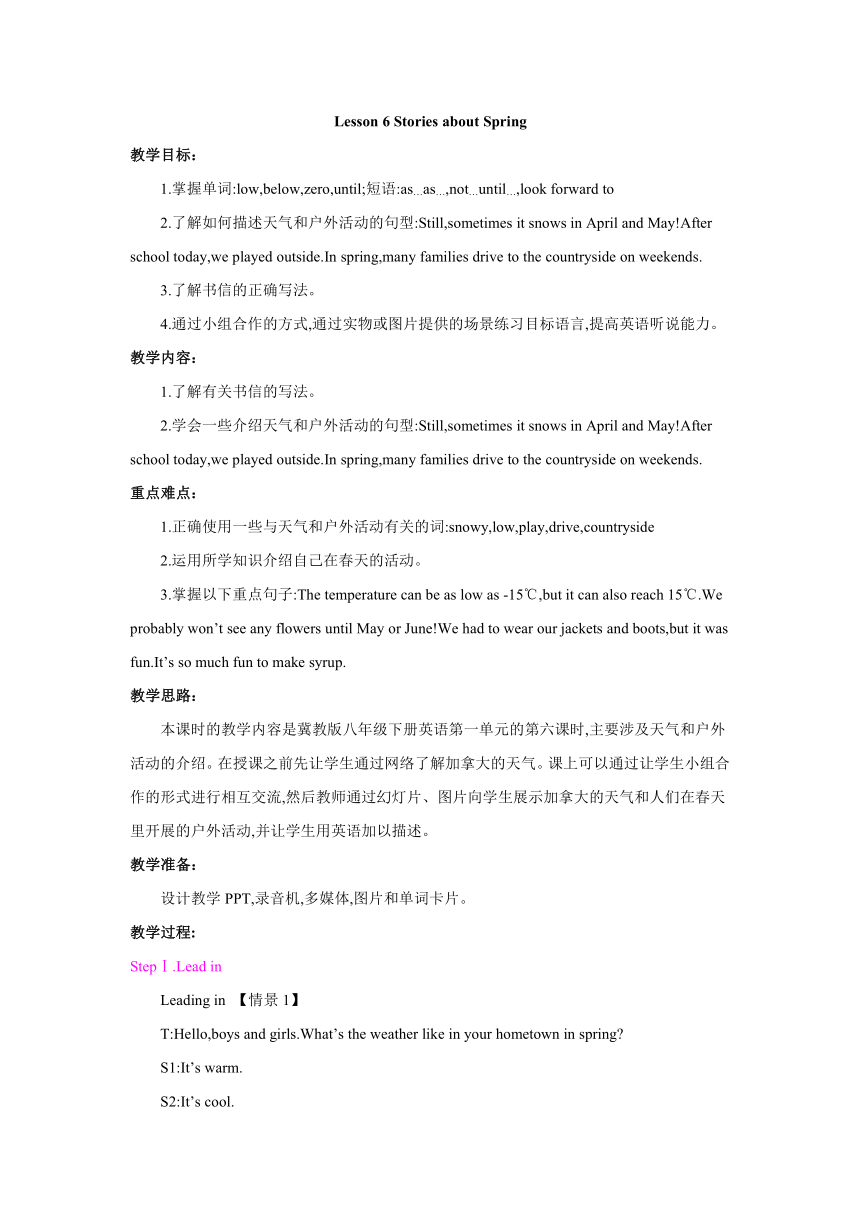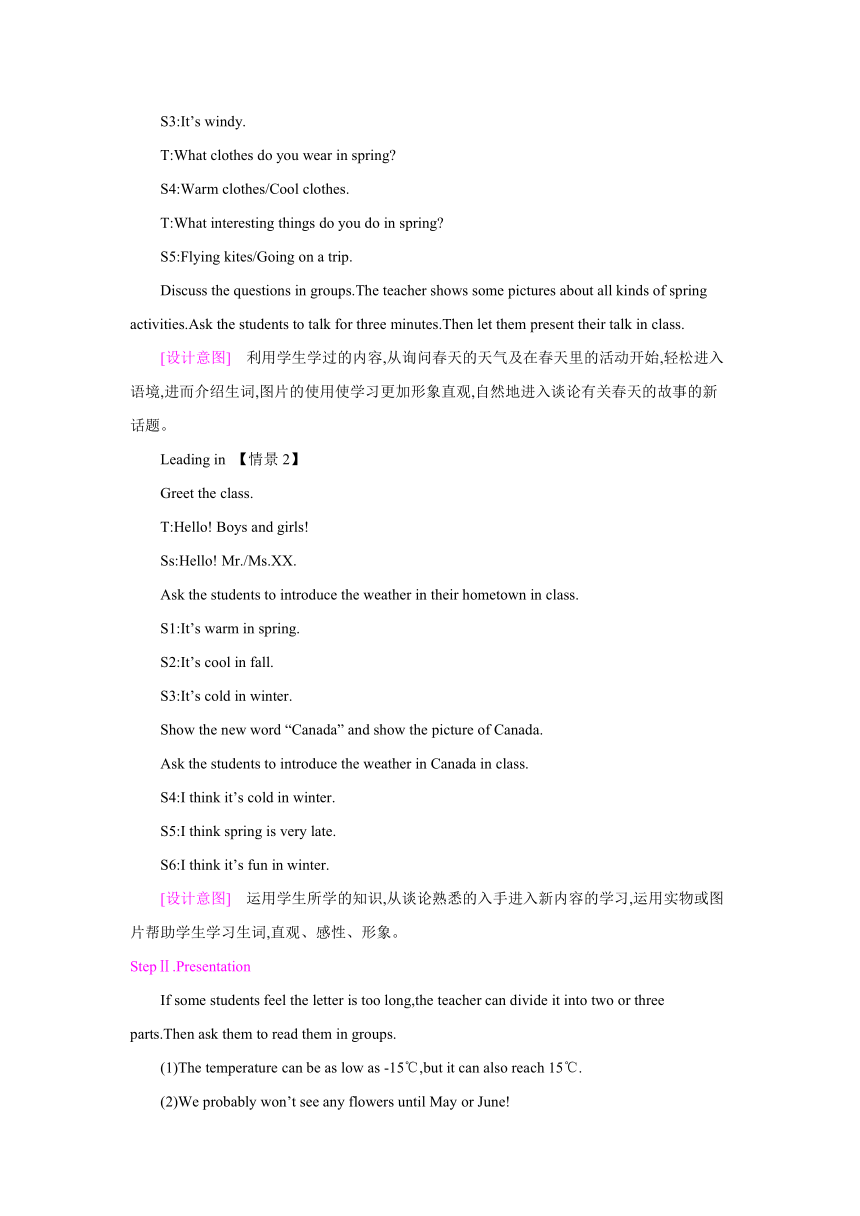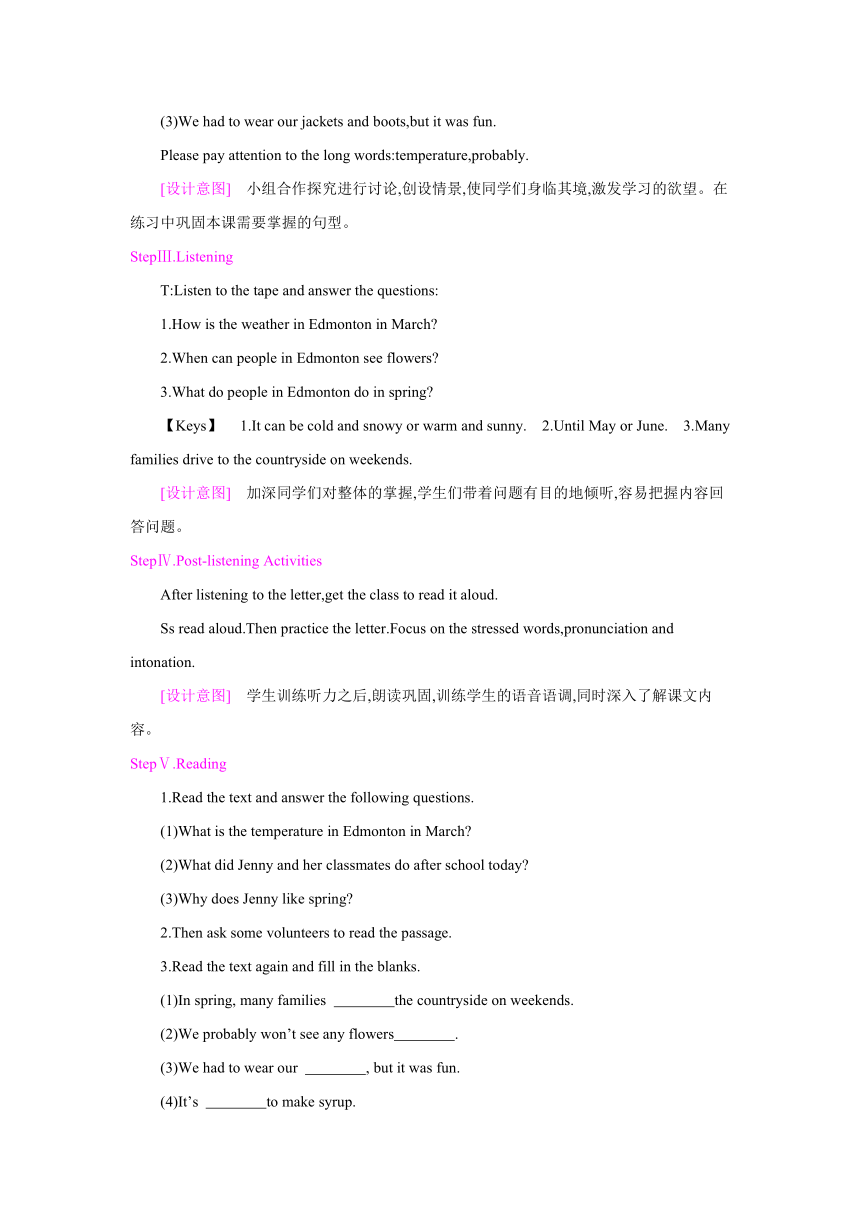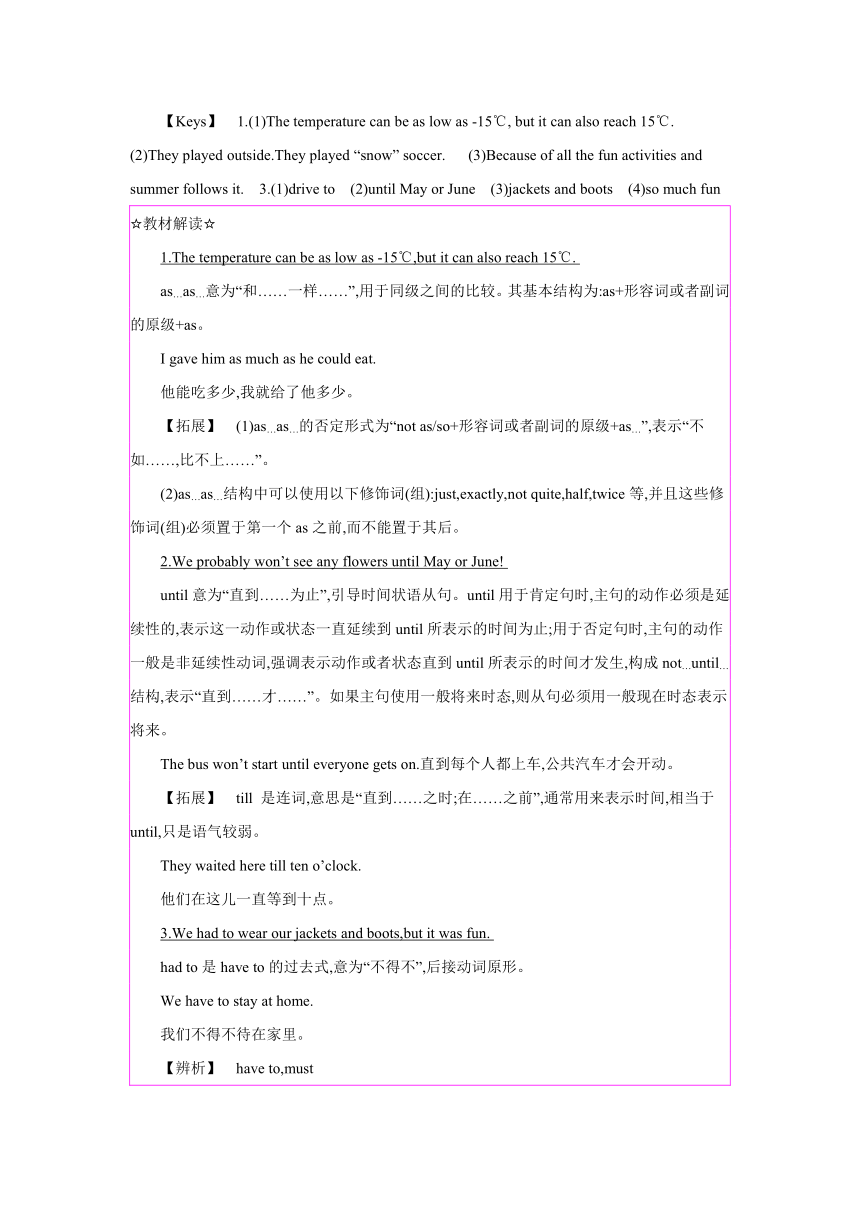Lesson 6 Stories about Spring 教学设计
文档属性
| 名称 | Lesson 6 Stories about Spring 教学设计 |  | |
| 格式 | zip | ||
| 文件大小 | 28.3KB | ||
| 资源类型 | 教案 | ||
| 版本资源 | 冀教版 | ||
| 科目 | 英语 | ||
| 更新时间 | 2019-06-28 06:43:57 | ||
图片预览




文档简介
Lesson 6 Stories about Spring
教学目标:
1.掌握单词:low,below,zero,until;短语:as…as…,not…until…,look forward to
2.了解如何描述天气和户外活动的句型:Still,sometimes it snows in April and May!After school today,we played outside.In spring,many families drive to the countryside on weekends.
3.了解书信的正确写法。
4.通过小组合作的方式,通过实物或图片提供的场景练习目标语言,提高英语听说能力。
教学内容:
1.了解有关书信的写法。
2.学会一些介绍天气和户外活动的句型:Still,sometimes it snows in April and May!After school today,we played outside.In spring,many families drive to the countryside on weekends.
重点难点:
1.正确使用一些与天气和户外活动有关的词:snowy,low,play,drive,countryside
2.运用所学知识介绍自己在春天的活动。
3.掌握以下重点句子:The temperature can be as low as -15℃,but it can also reach 15℃.We probably won’t see any flowers until May or June!We had to wear our jackets and boots,but it was fun.It’s so much fun to make syrup.
教学思路:
本课时的教学内容是冀教版八年级下册英语第一单元的第六课时,主要涉及天气和户外活动的介绍。在授课之前先让学生通过网络了解加拿大的天气。课上可以通过让学生小组合作的形式进行相互交流,然后教师通过幻灯片、图片向学生展示加拿大的天气和人们在春天里开展的户外活动,并让学生用英语加以描述。
教学准备:
设计教学PPT,录音机,多媒体,图片和单词卡片。
教学过程:
StepⅠ.Lead in
Leading in 【情景1】
T:Hello,boys and girls.What’s the weather like in your hometown in spring?
S1:It’s warm.
S2:It’s cool.
S3:It’s windy.
T:What clothes do you wear in spring?
S4:Warm clothes/Cool clothes.
T:What interesting things do you do in spring?
S5:Flying kites/Going on a trip.
Discuss the questions in groups.The teacher shows some pictures about all kinds of spring activities.Ask the students to talk for three minutes.Then let them present their talk in class.
[设计意图] 利用学生学过的内容,从询问春天的天气及在春天里的活动开始,轻松进入语境,进而介绍生词,图片的使用使学习更加形象直观,自然地进入谈论有关春天的故事的新话题。
Leading in 【情景2】
Greet the class.
T:Hello! Boys and girls!
Ss:Hello! Mr./Ms.XX.
Ask the students to introduce the weather in their hometown in class.
S1:It’s warm in spring.
S2:It’s cool in fall.
S3:It’s cold in winter.
Show the new word “Canada” and show the picture of Canada.
Ask the students to introduce the weather in Canada in class.
S4:I think it’s cold in winter.
S5:I think spring is very late.
S6:I think it’s fun in winter.
[设计意图] 运用学生所学的知识,从谈论熟悉的入手进入新内容的学习,运用实物或图片帮助学生学习生词,直观、感性、形象。
StepⅡ.Presentation
If some students feel the letter is too long,the teacher can divide it into two or three parts.Then ask them to read them in groups.
(1)The temperature can be as low as -15℃,but it can also reach 15℃.
(2)We probably won’t see any flowers until May or June!
(3)We had to wear our jackets and boots,but it was fun.
Please pay attention to the long words:temperature,probably.
[设计意图] 小组合作探究进行讨论,创设情景,使同学们身临其境,激发学习的欲望。在练习中巩固本课需要掌握的句型。
StepⅢ.Listening
T:Listen to the tape and answer the questions:
1.How is the weather in Edmonton in March?
2.When can people in Edmonton see flowers?
3.What do people in Edmonton do in spring?
【Keys】 1.It can be cold and snowy or warm and sunny. 2.Until May or June. 3.Many families drive to the countryside on weekends.
[设计意图] 加深同学们对整体的掌握,学生们带着问题有目的地倾听,容易把握内容回答问题。
StepⅣ.Post-listening Activities
After listening to the letter,get the class to read it aloud.
Ss read aloud.Then practice the letter.Focus on the stressed words,pronunciation and intonation.
[设计意图] 学生训练听力之后,朗读巩固,训练学生的语音语调,同时深入了解课文内容。
StepⅤ.Reading
1.Read the text and answer the following questions.
(1)What is the temperature in Edmonton in March?
(2)What did Jenny and her classmates do after school today?
(3)Why does Jenny like spring?
2.Then ask some volunteers to read the passage.
3.Read the text again and fill in the blanks.
(1)In spring, many families the countryside on weekends.?
(2)We probably won’t see any flowers .?
(3)We had to wear our , but it was fun. ?
(4)It’s to make syrup.?
【Keys】 1.(1)The temperature can be as low as -15℃, but it can also reach 15℃. (2)They played outside.They played “snow” soccer. (3)Because of all the fun activities and summer follows it. 3.(1)drive to (2)until May or June (3)jackets and boots (4)so much fun
☆教材解读☆
1.The temperature can be as low as -15℃,but it can also reach 15℃.?
as…as…意为“和……一样……”,用于同级之间的比较。其基本结构为:as+形容词或者副词的原级+as。
I gave him as much as he could eat.
他能吃多少,我就给了他多少。
【拓展】 (1)as…as…的否定形式为“not as/so+形容词或者副词的原级+as…”,表示“不如……,比不上……”。
(2)as…as…结构中可以使用以下修饰词(组):just,exactly,not quite,half,twice等,并且这些修饰词(组)必须置于第一个as之前,而不能置于其后。
2.We probably won’t see any flowers until May or June!?
until意为“直到……为止”,引导时间状语从句。until用于肯定句时,主句的动作必须是延续性的,表示这一动作或状态一直延续到until所表示的时间为止;用于否定句时,主句的动作一般是非延续性动词,强调表示动作或者状态直到until所表示的时间才发生,构成not…until…结构,表示“直到……才……”。如果主句使用一般将来时态,则从句必须用一般现在时态表示将来。
The bus won’t start until everyone gets on.直到每个人都上车,公共汽车才会开动。
【拓展】 till 是连词,意思是“直到……之时;在……之前”,通常用来表示时间,相当于until,只是语气较弱。
They waited here till ten o’clock.
他们在这儿一直等到十点。
3.We had to wear our jackets and boots,but it was fun.?
had to是have to的过去式,意为“不得不”,后接动词原形。
We have to stay at home.
我们不得不待在家里。
【辨析】 have to,must
have to与 must均有“必须”的意思,但must强调人主观认为必须做某事,而have to强调客观情况迫使人不得不做某事;且must只用于一般现在时中,没有人称和数的变化,而have to可用于多种时态中,并且有人称和数的变化。
We must go to school on time.
我们必须按时上学。
She has to look after her baby at home.
她不得不在家照顾孩子。
4.Spring is a time to look forward to flowers and fresh food from the garden.?
look forward to意为“盼望;期待”,其中to 是介词,后接名词、代词或者动名词。
I’m looking forward to visiting the Great Wall.我盼望着去游览长城。
[设计意图] 学生通过阅读课文内容,了解重点内容,并且通过回答问题来巩固对课文的理解和掌握;学生反复朗读课文,完成填空练习,加深印象。
StepⅥ.Complete Let’s Do It!
Ask the students to read the letter and answer the questions in No.1 and fill in the blanks in No.2 by themselves.Then ask the students to finish No.3 in groups.
[设计意图] Let’s Do It! 部分中的No.1重点是阅读训练教学,包括了课文的大部分内容,No.2训练文中出现的重点词语,No.3则是培养学生对整体课文的把握。
StepⅦ.Task
GROUP WORK:Let’s Do It! No.4
Ask students to come to the front of the classroom,and some start walking towards others as the teacher says “go”.They must stop as the teacher says “stop”.Then they can make up a new group and share what they do in spring.
[设计意图] No.4的重点是口语练习。同学们通过随机组合来完成小组合作。以“谈论春天可以做的事”为话题,提供了一个语境完整、内容丰富的话题,自然呈现本单元的核心句型,为学生进一步输出语言提供了口语示范。
StepⅧ.Exercises
T:Now,look at the sentences with some missing words.Please use proper words to fill them.
1.The temperature is so l that we have to wear warm clothes.?
2.Children of four and b can go to the zoo for free.?
3.Water turns into ice at z degrees Celsius.?
4.I didn’t go to bed u my parents come back.?
5.It has so much f to make syrup.?
【Keys】 1.low 2.below 3.zero 4.until 5.fun
[设计意图] 以学评教、强化落实。当堂检测主要是由本节内容组成的形成性评价,利用已知的信息,让学生补充,让他们得到充分的训练。
StepⅨ.Homework
1.Practice the letter with your group members after class.
2.Copy the new words twice.
[设计意图] 口头练习和单词记忆相结合,复习、归纳,注重语言知识的操练与积累。
Lesson 6 Stories about Spring
low,below,zero,until
Still,sometimes it snows in April and May!
After school today,we played outside.
In spring,many families drive to the countryside on weekends.
The temperature can be as low as -15℃,but it can also reach 15℃.
We probably won’t see any flowers until May or June!
We had to wear our jackets and boots,but it was fun.
It’s so much fun to make syrup.
教材习题解答
【Lesson 6】
1 1.Because in Edmonton the weather in March can be cold and snowy or warm and sunny. 2.Drive to the countryside on the weekend and make syrup. 3.Because of all the fun activities.
2 1.until 2.zero 3.low 4.drop
3 C A B
【Unit Review】
Building Your Vocabulary
Ⅰ instead push nearly wind plenty long spring
Ⅱ 1.plenty of 2.Neither;nor 3.activities 4.pushed 5.not;until 6.average
Grammar in Use
newspaper hometown countryside thunderstorm
anymore playground hillside sunset weekend
Putting It All Together
1.Fifteen days. 2.Firework shows,dragon dancing and lion dancing are common. 3.Because they are round,yellow and hot,just like the sun. 4.Indian people.
语法精讲
构词法——合成词
合成词:由两个或更多的词合成一个词。合成词在英语中比较活跃。合成名词的数量很大,可以在句中作主语、宾语等。
1.合成名词常见的构词方法如下:
(1)名词+名词:
basket +ball →basketball (篮球) rail +way →railway (铁路)
(2)形容词+名词:
short+ hand →shorthand(速记) black +board→blackboard(黑板)
(3)动名词+名词:
waiting+ room → waiting-room(候车室)
(4)动词+名词:
play +ground →playground(操场)
(5)动词+副词:
get+together→get-together(聚会) break+through→break-through (突破)
(6)副词+名词:
out+ side →outside(外面) up+ stairs →upstairs(楼上)
(7)介词+名词
over+ coat →overcoat(外套) after+ noon→afternoon(下午)
2.合成形容词常见的构词方法如下:
(1)形容词+名词+-ed:
good-tempered(好脾气的) noble-minded (高贵的,高尚的)
(2)形容词+现在分词:
good-looking (长得好看的) easy-going (容易相处的)
(3)副词+现在分词:
hard-working (努力工作的) far-reaching (深远的,广泛的)
(4)名词+过去分词:
state-owned (国有的) heart-felt (衷心的)
(5)名词+现在分词:
peace-loving(爱好和平的) epoch-making(开创新纪元的)
(6)副词+过去分词:
well-known (著名的) widespread (传播广的)
(7)形容词+过去分词:
kind-hearted(好心肠的) ready-made (做好的,现成的)
(8)名词+形容词:
duty-free (免税的) self-satisfied(自我满足的,自负的)
教学目标:
1.掌握单词:low,below,zero,until;短语:as…as…,not…until…,look forward to
2.了解如何描述天气和户外活动的句型:Still,sometimes it snows in April and May!After school today,we played outside.In spring,many families drive to the countryside on weekends.
3.了解书信的正确写法。
4.通过小组合作的方式,通过实物或图片提供的场景练习目标语言,提高英语听说能力。
教学内容:
1.了解有关书信的写法。
2.学会一些介绍天气和户外活动的句型:Still,sometimes it snows in April and May!After school today,we played outside.In spring,many families drive to the countryside on weekends.
重点难点:
1.正确使用一些与天气和户外活动有关的词:snowy,low,play,drive,countryside
2.运用所学知识介绍自己在春天的活动。
3.掌握以下重点句子:The temperature can be as low as -15℃,but it can also reach 15℃.We probably won’t see any flowers until May or June!We had to wear our jackets and boots,but it was fun.It’s so much fun to make syrup.
教学思路:
本课时的教学内容是冀教版八年级下册英语第一单元的第六课时,主要涉及天气和户外活动的介绍。在授课之前先让学生通过网络了解加拿大的天气。课上可以通过让学生小组合作的形式进行相互交流,然后教师通过幻灯片、图片向学生展示加拿大的天气和人们在春天里开展的户外活动,并让学生用英语加以描述。
教学准备:
设计教学PPT,录音机,多媒体,图片和单词卡片。
教学过程:
StepⅠ.Lead in
Leading in 【情景1】
T:Hello,boys and girls.What’s the weather like in your hometown in spring?
S1:It’s warm.
S2:It’s cool.
S3:It’s windy.
T:What clothes do you wear in spring?
S4:Warm clothes/Cool clothes.
T:What interesting things do you do in spring?
S5:Flying kites/Going on a trip.
Discuss the questions in groups.The teacher shows some pictures about all kinds of spring activities.Ask the students to talk for three minutes.Then let them present their talk in class.
[设计意图] 利用学生学过的内容,从询问春天的天气及在春天里的活动开始,轻松进入语境,进而介绍生词,图片的使用使学习更加形象直观,自然地进入谈论有关春天的故事的新话题。
Leading in 【情景2】
Greet the class.
T:Hello! Boys and girls!
Ss:Hello! Mr./Ms.XX.
Ask the students to introduce the weather in their hometown in class.
S1:It’s warm in spring.
S2:It’s cool in fall.
S3:It’s cold in winter.
Show the new word “Canada” and show the picture of Canada.
Ask the students to introduce the weather in Canada in class.
S4:I think it’s cold in winter.
S5:I think spring is very late.
S6:I think it’s fun in winter.
[设计意图] 运用学生所学的知识,从谈论熟悉的入手进入新内容的学习,运用实物或图片帮助学生学习生词,直观、感性、形象。
StepⅡ.Presentation
If some students feel the letter is too long,the teacher can divide it into two or three parts.Then ask them to read them in groups.
(1)The temperature can be as low as -15℃,but it can also reach 15℃.
(2)We probably won’t see any flowers until May or June!
(3)We had to wear our jackets and boots,but it was fun.
Please pay attention to the long words:temperature,probably.
[设计意图] 小组合作探究进行讨论,创设情景,使同学们身临其境,激发学习的欲望。在练习中巩固本课需要掌握的句型。
StepⅢ.Listening
T:Listen to the tape and answer the questions:
1.How is the weather in Edmonton in March?
2.When can people in Edmonton see flowers?
3.What do people in Edmonton do in spring?
【Keys】 1.It can be cold and snowy or warm and sunny. 2.Until May or June. 3.Many families drive to the countryside on weekends.
[设计意图] 加深同学们对整体的掌握,学生们带着问题有目的地倾听,容易把握内容回答问题。
StepⅣ.Post-listening Activities
After listening to the letter,get the class to read it aloud.
Ss read aloud.Then practice the letter.Focus on the stressed words,pronunciation and intonation.
[设计意图] 学生训练听力之后,朗读巩固,训练学生的语音语调,同时深入了解课文内容。
StepⅤ.Reading
1.Read the text and answer the following questions.
(1)What is the temperature in Edmonton in March?
(2)What did Jenny and her classmates do after school today?
(3)Why does Jenny like spring?
2.Then ask some volunteers to read the passage.
3.Read the text again and fill in the blanks.
(1)In spring, many families the countryside on weekends.?
(2)We probably won’t see any flowers .?
(3)We had to wear our , but it was fun. ?
(4)It’s to make syrup.?
【Keys】 1.(1)The temperature can be as low as -15℃, but it can also reach 15℃. (2)They played outside.They played “snow” soccer. (3)Because of all the fun activities and summer follows it. 3.(1)drive to (2)until May or June (3)jackets and boots (4)so much fun
☆教材解读☆
1.The temperature can be as low as -15℃,but it can also reach 15℃.?
as…as…意为“和……一样……”,用于同级之间的比较。其基本结构为:as+形容词或者副词的原级+as。
I gave him as much as he could eat.
他能吃多少,我就给了他多少。
【拓展】 (1)as…as…的否定形式为“not as/so+形容词或者副词的原级+as…”,表示“不如……,比不上……”。
(2)as…as…结构中可以使用以下修饰词(组):just,exactly,not quite,half,twice等,并且这些修饰词(组)必须置于第一个as之前,而不能置于其后。
2.We probably won’t see any flowers until May or June!?
until意为“直到……为止”,引导时间状语从句。until用于肯定句时,主句的动作必须是延续性的,表示这一动作或状态一直延续到until所表示的时间为止;用于否定句时,主句的动作一般是非延续性动词,强调表示动作或者状态直到until所表示的时间才发生,构成not…until…结构,表示“直到……才……”。如果主句使用一般将来时态,则从句必须用一般现在时态表示将来。
The bus won’t start until everyone gets on.直到每个人都上车,公共汽车才会开动。
【拓展】 till 是连词,意思是“直到……之时;在……之前”,通常用来表示时间,相当于until,只是语气较弱。
They waited here till ten o’clock.
他们在这儿一直等到十点。
3.We had to wear our jackets and boots,but it was fun.?
had to是have to的过去式,意为“不得不”,后接动词原形。
We have to stay at home.
我们不得不待在家里。
【辨析】 have to,must
have to与 must均有“必须”的意思,但must强调人主观认为必须做某事,而have to强调客观情况迫使人不得不做某事;且must只用于一般现在时中,没有人称和数的变化,而have to可用于多种时态中,并且有人称和数的变化。
We must go to school on time.
我们必须按时上学。
She has to look after her baby at home.
她不得不在家照顾孩子。
4.Spring is a time to look forward to flowers and fresh food from the garden.?
look forward to意为“盼望;期待”,其中to 是介词,后接名词、代词或者动名词。
I’m looking forward to visiting the Great Wall.我盼望着去游览长城。
[设计意图] 学生通过阅读课文内容,了解重点内容,并且通过回答问题来巩固对课文的理解和掌握;学生反复朗读课文,完成填空练习,加深印象。
StepⅥ.Complete Let’s Do It!
Ask the students to read the letter and answer the questions in No.1 and fill in the blanks in No.2 by themselves.Then ask the students to finish No.3 in groups.
[设计意图] Let’s Do It! 部分中的No.1重点是阅读训练教学,包括了课文的大部分内容,No.2训练文中出现的重点词语,No.3则是培养学生对整体课文的把握。
StepⅦ.Task
GROUP WORK:Let’s Do It! No.4
Ask students to come to the front of the classroom,and some start walking towards others as the teacher says “go”.They must stop as the teacher says “stop”.Then they can make up a new group and share what they do in spring.
[设计意图] No.4的重点是口语练习。同学们通过随机组合来完成小组合作。以“谈论春天可以做的事”为话题,提供了一个语境完整、内容丰富的话题,自然呈现本单元的核心句型,为学生进一步输出语言提供了口语示范。
StepⅧ.Exercises
T:Now,look at the sentences with some missing words.Please use proper words to fill them.
1.The temperature is so l that we have to wear warm clothes.?
2.Children of four and b can go to the zoo for free.?
3.Water turns into ice at z degrees Celsius.?
4.I didn’t go to bed u my parents come back.?
5.It has so much f to make syrup.?
【Keys】 1.low 2.below 3.zero 4.until 5.fun
[设计意图] 以学评教、强化落实。当堂检测主要是由本节内容组成的形成性评价,利用已知的信息,让学生补充,让他们得到充分的训练。
StepⅨ.Homework
1.Practice the letter with your group members after class.
2.Copy the new words twice.
[设计意图] 口头练习和单词记忆相结合,复习、归纳,注重语言知识的操练与积累。
Lesson 6 Stories about Spring
low,below,zero,until
Still,sometimes it snows in April and May!
After school today,we played outside.
In spring,many families drive to the countryside on weekends.
The temperature can be as low as -15℃,but it can also reach 15℃.
We probably won’t see any flowers until May or June!
We had to wear our jackets and boots,but it was fun.
It’s so much fun to make syrup.
教材习题解答
【Lesson 6】
1 1.Because in Edmonton the weather in March can be cold and snowy or warm and sunny. 2.Drive to the countryside on the weekend and make syrup. 3.Because of all the fun activities.
2 1.until 2.zero 3.low 4.drop
3 C A B
【Unit Review】
Building Your Vocabulary
Ⅰ instead push nearly wind plenty long spring
Ⅱ 1.plenty of 2.Neither;nor 3.activities 4.pushed 5.not;until 6.average
Grammar in Use
newspaper hometown countryside thunderstorm
anymore playground hillside sunset weekend
Putting It All Together
1.Fifteen days. 2.Firework shows,dragon dancing and lion dancing are common. 3.Because they are round,yellow and hot,just like the sun. 4.Indian people.
语法精讲
构词法——合成词
合成词:由两个或更多的词合成一个词。合成词在英语中比较活跃。合成名词的数量很大,可以在句中作主语、宾语等。
1.合成名词常见的构词方法如下:
(1)名词+名词:
basket +ball →basketball (篮球) rail +way →railway (铁路)
(2)形容词+名词:
short+ hand →shorthand(速记) black +board→blackboard(黑板)
(3)动名词+名词:
waiting+ room → waiting-room(候车室)
(4)动词+名词:
play +ground →playground(操场)
(5)动词+副词:
get+together→get-together(聚会) break+through→break-through (突破)
(6)副词+名词:
out+ side →outside(外面) up+ stairs →upstairs(楼上)
(7)介词+名词
over+ coat →overcoat(外套) after+ noon→afternoon(下午)
2.合成形容词常见的构词方法如下:
(1)形容词+名词+-ed:
good-tempered(好脾气的) noble-minded (高贵的,高尚的)
(2)形容词+现在分词:
good-looking (长得好看的) easy-going (容易相处的)
(3)副词+现在分词:
hard-working (努力工作的) far-reaching (深远的,广泛的)
(4)名词+过去分词:
state-owned (国有的) heart-felt (衷心的)
(5)名词+现在分词:
peace-loving(爱好和平的) epoch-making(开创新纪元的)
(6)副词+过去分词:
well-known (著名的) widespread (传播广的)
(7)形容词+过去分词:
kind-hearted(好心肠的) ready-made (做好的,现成的)
(8)名词+形容词:
duty-free (免税的) self-satisfied(自我满足的,自负的)
同课章节目录
- Unit 1 Spring Is Coming
- Lesson 1 How's the weather?
- Lesson 2 It's Getting Warmer!
- Lesson 3 Sun Is Rising
- Lesson 4 The Spring City
- Lesson 5 Babysitting on a Spring Day
- Lesson 6 Stories about Spring
- Unit 2 Plant a Plant
- Lesson 7 Planting Trees
- Lesson 8 Why Are Plants Important?
- Lesson 9 Gardening with Mary
- Lesson 10 Make Your Garden Grow!
- Lesson 11 Amazing Plants
- Lesson 12 Danny's Plant
- Unit 3 Animals Are Our Friends
- Lesson 13 Danny's Big Scare
- Lesson 14 Amazing Animals
- Lesson 15 The Zoo Is Open
- Lesson 16 The Pear Escaped
- Lesson 17 Save the Tigers
- Lesson 18 Friendship Between Animals
- Unit 4 The Internet Connects Us
- Lesson 19 How Do You Use the Internet?
- Lesson 20 A Computer Helps!
- Lesson 21 Books or Computers?
- Lesson 22 Travel on the Internet
- Lesson 23 The Internet--Good or Bad?
- Lesson 24 An E-mail to Grandpa
- Unit 5 Buying and Selling
- Lesson 25 Raising Money
- Lesson 26 Cookies, Please!
- Lesson 27 Business English
- Lesson 28 Ms. Liu's Great Idea
- Lesson 29 How to Push a Product
- Lesson 30 A Cookie Sale
- Unit 6 Be a Champion!
- Lesson 31 Don't Fall, Danny
- Lesson 32 My Favourite Record
- Lesson 33 2800 Years of Sports
- Lesson 34 Modern Olympics
- Lesson 35 The Dream Team
- Lesson 36 Classroom Olympics
- Unit 7 Know Our World
- Lesson 37 Let's Learn Geography!
- Lesson 38 The World Is a Big Place
- Lesson 39 Ring Up or Call?
- Lesson 40 Body Language
- Lesson 41 A Class of the World
- Lesson 42 North America
- Unit 8 Save Our World
- Lesson 43 Let's Clean Up!
- Lesson 44 Environment Clubs
- Lesson 45 Let's Sort Garbage!
- Lesson 46 Protect Our Environment
- Lesson 47 Connected to Nature
- Lesson 48 Garbage Is Interesting!
